Contents
Small, dense, aesthetic looking Brussels sprouts are an integral part of modern cooking. A special, rich taste makes it desirable on any table and decorates both first and second courses. And in terms of the content of vitamins and minerals, it exceeds the usual white head by 3-4 times. However, not many gardeners decide to plant it on their site. Meanwhile, Brussels sprouts, their cultivation and care do not require much effort and expense.
Popular varieties
There are traditional varieties and F1 hybrids. Brussels sprouts of traditional varieties are characterized by larger buds with better taste characteristics. Their harvest period is longer, but ripe sprouts open quickly. Several varieties are especially popular among this group. For example, Bedford-Fillbasket and Bedford-Asmer Monitor are suitable for growing in small areas, they are distinguished by especially large heads and tall stems. But Noisette and Roodnerf-Early Buttons, Roodnerf-Seven Hills have a smaller crop size, but with a brighter nutty flavor, in addition, their fruits remain dense for a long time, even after being cut. Rubine red varieties are gaining great popularity. They are used both cooked and raw in various salads due to their delicate and mild taste.
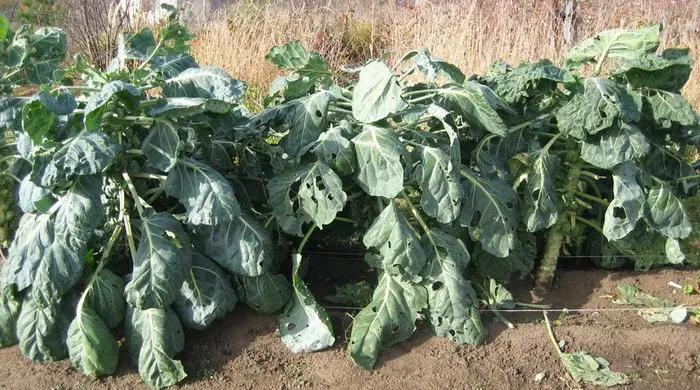
The F1 hybrids obtained as a result of free crossing are increasingly used in the cultivation of Brussels sprouts, as they produce a greater number of cabbages, with relatively low stems. In addition, their maturation occurs almost simultaneously, while the buds are located along the entire height of the stem and remain tightly rolled for several weeks. The most popular among the Peergynt and Oliver hybrids, early and medium fruiting, the first ovaries are formed in September, and in mid-October – early November, you can already harvest. Citadel differs from others in dark fruits that are best for freezing and a short stem. One of the best late varieties of Dolmic and Rampart, not demanding on the soil, resistant to frost and many diseases, cabbage after cooking does not have the bitterness characteristic of this crop. The Sherif hybrid is characterized by high yields, uniform in size, not large heads of cabbage with high palatability.
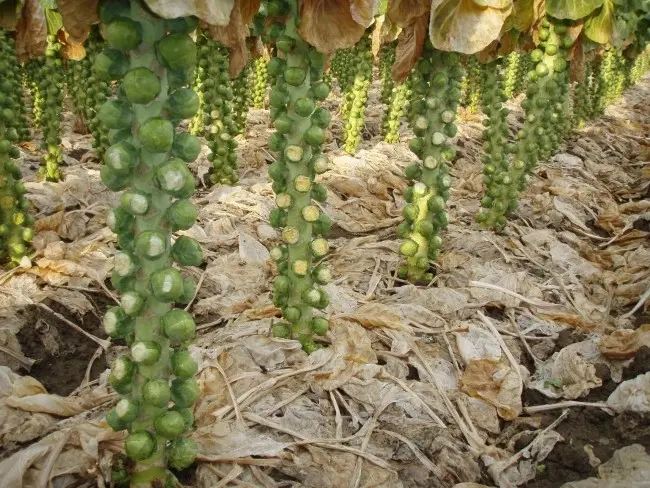
Cultivation
Cabbage seeds germinate at a temperature of 3-4C, and at 17-19C shoots appear on the 3rd-4th day. The culture, in comparison with the white-headed one, is more cold-resistant, withstands frosts down to -7-12C. At 24-26C in shading, the formation of the plant is noticeably delayed and the quality of the crop decreases. Brussels sprouts are sown from April 9-13, choosing well-lit, dry areas, under film or glass. It is desirable that potatoes, carrots, onions, cucumbers, cereals, legumes, or siderats be grown on them before. The plant will develop poorly in areas where its predecessors were tomatoes, beets, radishes, radishes, turnips. Re-planting cabbage in the same place is possible only after 4-5 years. Seedlings are planted in open ground from the beginning of June, until mid-May, no later than, otherwise the harvest will have to be unripe.
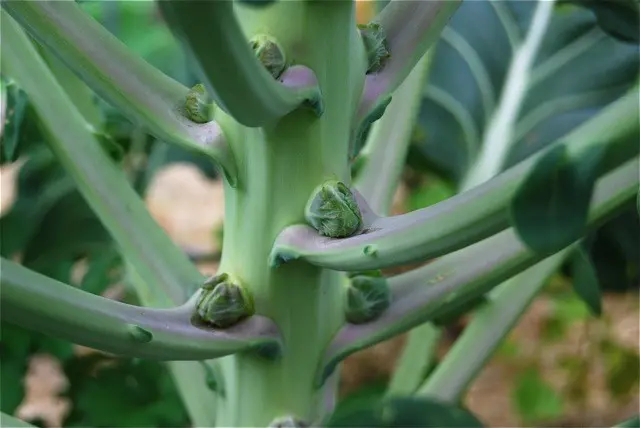
Soil preparation and sowing
The soil for planting has been prepared since the autumn of the previous year. The site is deeply dug up and organic fertilizers (humus, compost, mullein) are applied in the amount of 1,5-2 buckets per square meter. For the winter, it remains open, for drinks with moisture when the snow melts. In early spring, when a positive temperature sets in, the soil is loosened shallowly by 3,5-5,5 cm and 120-150 g of chicken manure is applied per 1 sq. m.
Brussels sprout seeds are sown from mid-March, early April, in holes 10-13 cm deep, at a distance of 12-16 cm from each other. In order for them to germinate, the planting is covered with cellophane. When the seeds begin to germinate, 2-3 thinnings are carried out, leaving the taller ones and giving them space for further development.
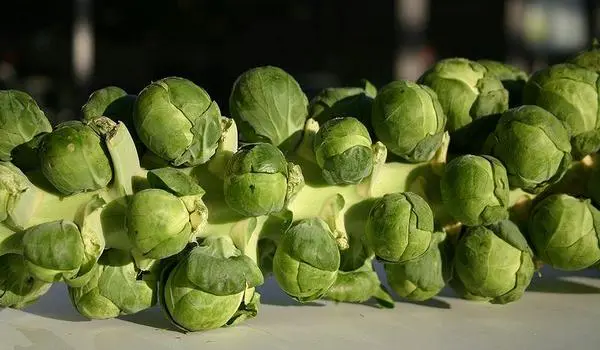
Seedling seedlings
Seedlings are planted when they reach 12-16 cm in height. When planting, it should be borne in mind that one plant will need a plot measuring 60-70 cm wide and 50-60 cm long. Therefore, there should be at least 90-120 cm between plants. One day before direct planting at the place of maturation, the seedlings are watered abundantly. Plant it in such a way that the lower leaves are slightly above the soil level. Since this is a rather tall culture, immediately or as it grows, a support is installed on which the trunk is tied up so that strong winds do not damage it.
Care
To harvest the best quality crop, pinch the top of the plant during the heading period. The soil in the root zone is regularly and shallowly loosened and mulched with sawdust or straw with a layer of 6-8 cm. From the second week of September, the upper part of the plant is cut so that all the nutrients go to the formation and growth of the crop. It should be borne in mind that such manipulations reduce the frost resistance of cabbage.
Just like ordinary white cabbage, Brussels sprouts require timely fertilization and regular watering. It is worth noting that their excess makes the heads of cabbage loose and not suitable for use in food. If the plant lacks nitrogen, after a period of rain, the leaves of the lower tier turn yellow and fall off.

Inter-row processing
Since Brussels sprouts are slow growing plants, it is advisable to sow the aisles with cucumbers, beans or green manure. Regular inter-row cultivation is an integral part of plant care. It provides a favorable water-air regime necessary for full growth and development.
During the summer period, about 6-7 loosenings are carried out, clearing the planting from weeds. The first is especially important, because after planting the soil is strongly compacted. If you delay and loosen the earth later, growth retardation and an increase in plant dropouts are possible, especially on heavy soils. In this case, in place of the dead seedlings, the one left in reserve is planted within a week. When planting potted seedlings, the first loosening is carried out the next day after planting, with potless seedlings – after 3-4 days. This culture does not require hilling, since the largest heads of cabbage are formed in the axils of the lower leaves and cannot be covered with soil.
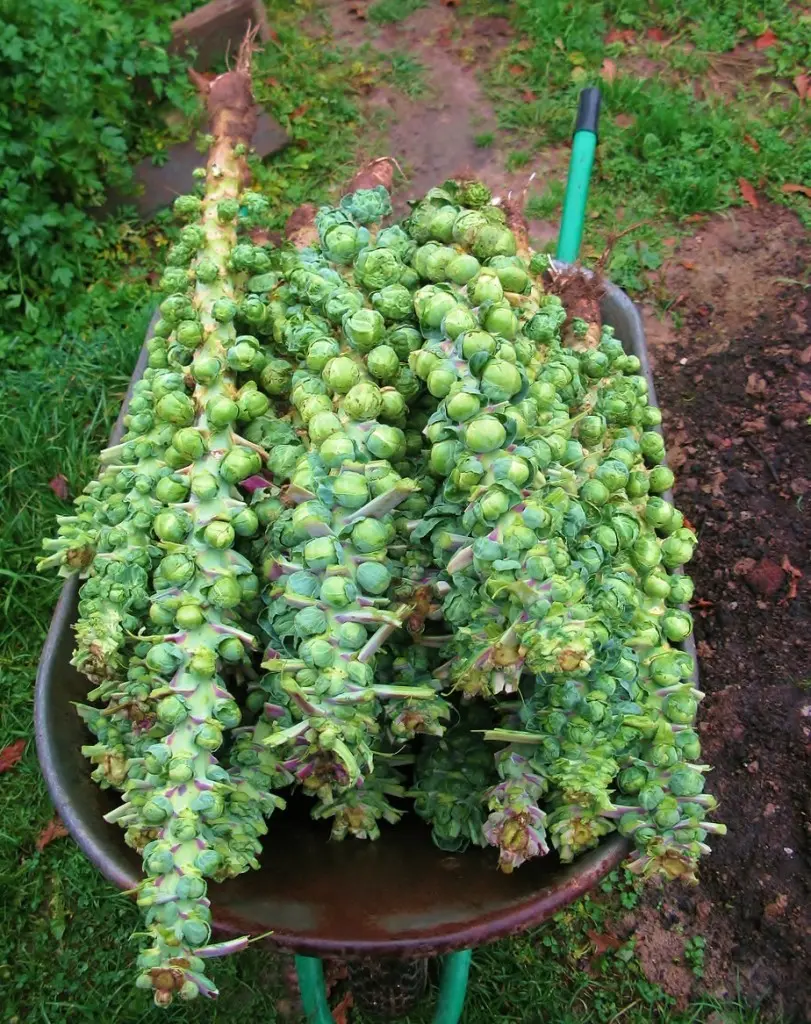
Watering and feeding
The first post-planting top dressing is carried out 12-16 days after planting, followed by the formation of sprouts. In areas well fertilized with organic matter, it is possible to limit the application of nitrogen-containing fertilizers after planting, and when the first ovaries are formed, not a large amount of potassium salts. On soddy-podzolic soil, with low fertility, 7-10 g of urea or ammonium nitrate, 10-15 g of superphosphate, 5-8 g of sulfate or potassium chloride per 1 sq. cm, to a depth of 9-12 cm.
For the second time, 10-14 g of ammonium nitrate, 10-16 g of superphosphate, and 8-10 g of potassium chloride are applied, placing fertilizers in the middle of row spacing to a depth of 12-15 cm. Often, complex fertilizers are used, such as nitrogen phosphate, nitrophoska, ecofoska or Kemiry. When sieving a dry mixture, it is immediately embedded in the ground with a hoe, after which the aisles are loosened shallowly.
During the summer, planting is watered 3-4 times, and on heavy soils, the number of waterings is increased to 5-6.
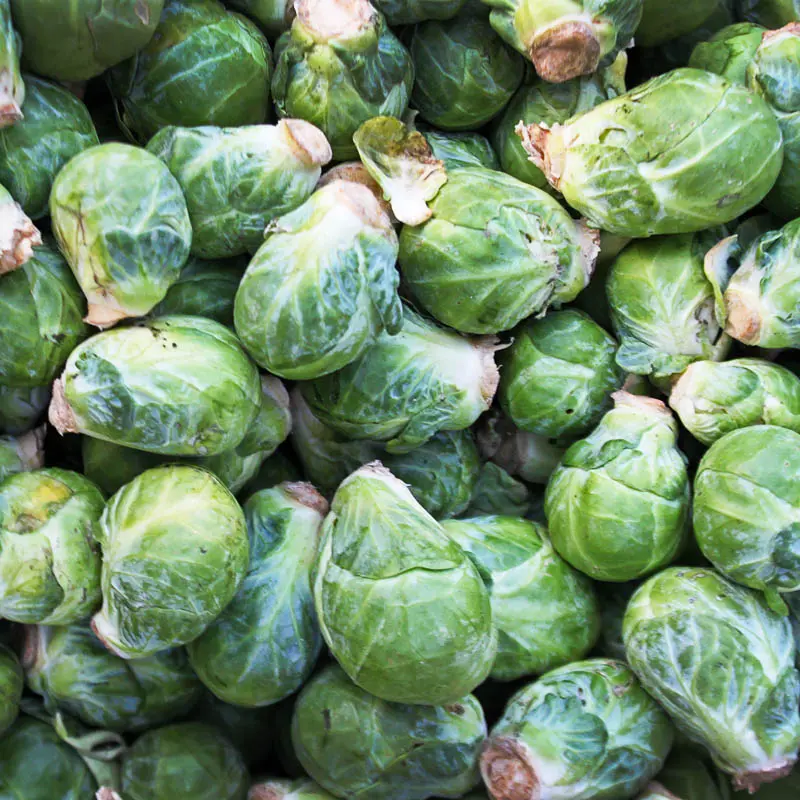
Harvesting
Depending on the variety, the crop is harvested from early to mid-October to November in several passes, since not all heads of cabbage when growing Brussels sprouts reach removable maturity at the same time. A slight frost only improves its taste. Fresh, dense heads of cabbage can be stored for quite a long time in a cool place. For a longer shelf life, cabbage is frozen. At the same time, it does not lose its positive properties at all.
Video “Growing Brussels sprouts”
This video talks about the nuances of care when growing Brussels sprouts to get more yield, about the beneficial properties of the plant.









